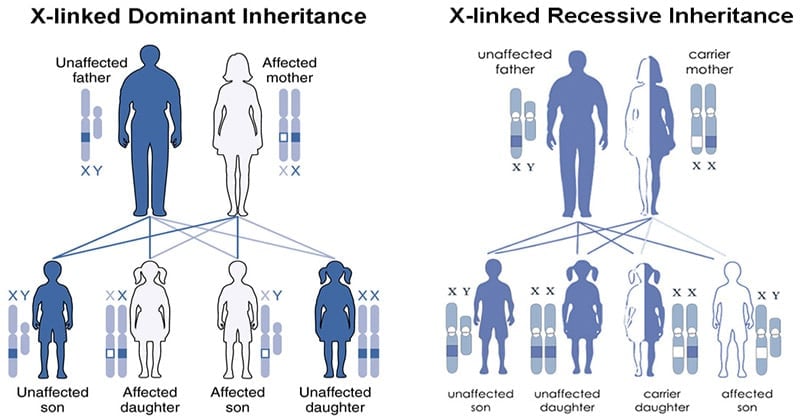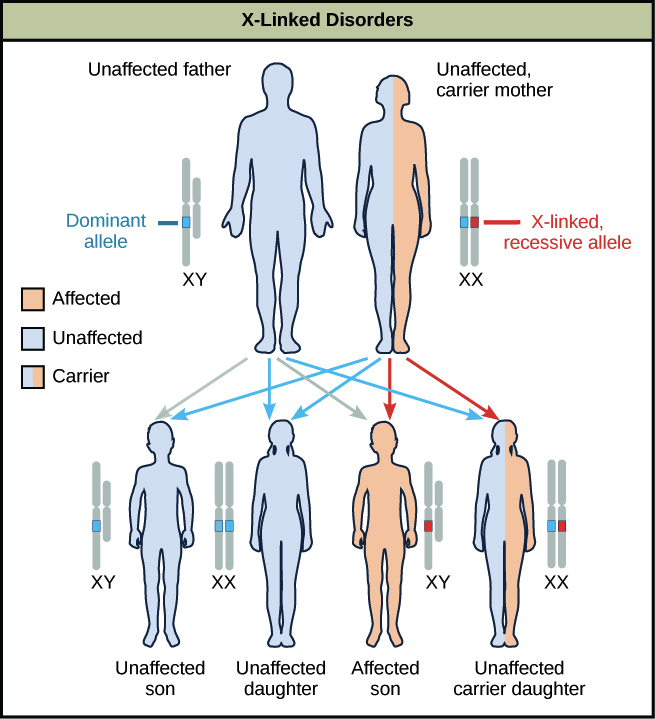Disclaimer: The information presented on this page is for academic, study, and educational purposes only. The terms and keywords used on this page may be offensive and not suitable for some users, but they are common genetic terms used only for educational purposes as a part of study information.
- Gender (s*x) makes no difference in Mendel’s crosses. But the Mendel’s laws are not applicable on those genes which are exclusively located either in X or Y chromosome.
- Sex-Linked Inheritance is the inheritance of a trait (phenotype) that is determined by a gene located on one of the sex chromosomes.
- The genes which occur exclusively on the X chromosome or on the analogous Z chromosome (in birds and other species) are called X- or Z -linked genes while the genes which exclusively occur in Y chromosome are called holandric genes.
- The inheritance of such X- or Z-linked and holandric genes is called sex-linked inheritance.

Interesting Science Videos
Characteristics of Sex-linked Inheritance
It has been observed that the genes occurring only in the X chromosomes are represented twice in female (because female contains 2X chromosomes) and once in male (because male has only one X chromosome).
The differential region of each chromosome (i.e., X) contain genes that have no counterparts on the other kind of sex chromosome. These genes, whether dominant or recessive, show their effects in the male phenotype. Genes in the differential regions are called hemizygous (“half zygous”) in the males.
Inheritance of X-Linked Recessive Genes
- The X-linked recessive genes show criss-cross pattern of inheritance.
In criss-cross inheritance, an X-linked recessive gene is transmitted from P1 male parent (father) to F2 male progeny (grandsons) through its F1 heterozygous females (daughters), which are called carriers) and different F1 and F2 results (ratios) in the reciprocal crosses.
- The X-linked recessive phenotype is usually found more frequently in the male than in the female. This is because an affected female can result only when both mother and father bear the X-linked recessive allele (e.g., XA Xa × Xa Y), whereas an affected male can result when only the mother carries the gene.
- Usually none of the offspring of an affected male will be affected, but all his daughters will carry the gene in masked heterozygous condition, so one half of their sons (i.e., grandsons of F1 father) will be affected.
- None of the sons of an affected male will inherit the X-linked recessive gene, so not only will they be free of the defective phenotype; but they will not pass the gene along to their offspring.
Example
In Drosophila, the gene for white eye colour is X linked and recessive to another X-linked, dominant gene for red-eye colour.
When white-eyed male was mated with a red-eyed female the F1 flies were all red-eyed. F2 generation of it included 3: 1 ratio of red and white-eyed flies. But all white eyed flies of F2 generation were males only. When normal female of F1 is crossed with normal male 50% of males were white-eyed and 50% were red-eyed It shows that the recessive allele is expressed in male only.
- The common sex-linked disorders that are mostly found in humans are mostly recessive. They include disorders like Color-blindness and Haemophilia.
Disorders in Human

Colour-blindness
It is a defect in which a person cannot distinguish between red, green or both the colours from other colours.
Haemophilia (Bleeder’s disease)
Haemophilia is called a royal disease and known as the most serious of all the diseases. A person suffering from this disease have the inability of their blood to clot normally even after a minor injury. It is due to the lack of a blood protein called clotting factor VIII and clotting factor IX.
Inheritance of X-Linked Dominant Genes
- Dominant X-linked genes are detected more frequently found in the female than in the male of the species.
- The affected males pass the condition on to all of their daughters but to none of their sons.
- Females usually pass the condition (defective phenotype) on to one-half of their sons and daughters.
- A X-linked dominant gene fails to be transmitted to any son from a mother which did not exhibit the trait itself.
Human Disorders
In humans, X-linked dominant conditions are relatively rare.
One example is hypophosphatemia (vitamin D-resistant rickets).
Another example includes hereditary enamel hypoplasia (hypoplastic amelogenesis imperfecta), in which tooth enamel is abnormally thin so that teeth appear small and wear rapidly down to the gums.
Inheritance of Y-Linked Genes
- Genes in the non-homologous region of the Y chromosome pass directly from male to male.
- In man, the Y-linked or holandric genes are transmitted directly from father to son.
Example
- Genes for ichthyosis hystrix gravis hypertrichosis (excessive development of hairs on pinna of ear)
- Genes for H-Y antigen, histocompatibility antigen, spermatogenesis, height(stature) and slower maturation of individual.
References
- Verma, P. S., & Agrawal, V. K. (2006). Cell Biology, Genetics, Molecular Biology, Evolution & Ecology (1 ed.). S .Chand and company Ltd.
- Gardner, E. J., Simmons, M. J., & Snustad, D. P. (1991). Principles of genetics. New York: J. Wiley.
- http://docenti.unicam.it/tmp/229.pdf
- https://www.kullabs.com/classes/subjects/units/lessons/notes/note-detail/8353
- https://www.slideshare.net/jmpalero/sex-linked-inheritance-65260691
- http://www.yourarticlelibrary.com/notes/useful-notes-on-sex-linked-inheritance-biology-853-words/6327
- http://notesforpakistan.blogspot.com/2009/10/sex-linked-inheritance-short-note.html
